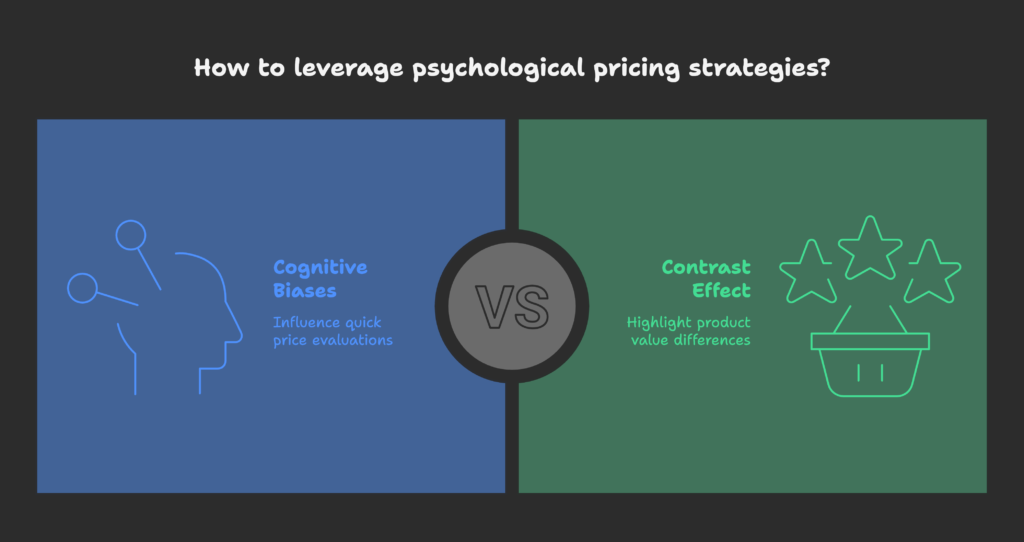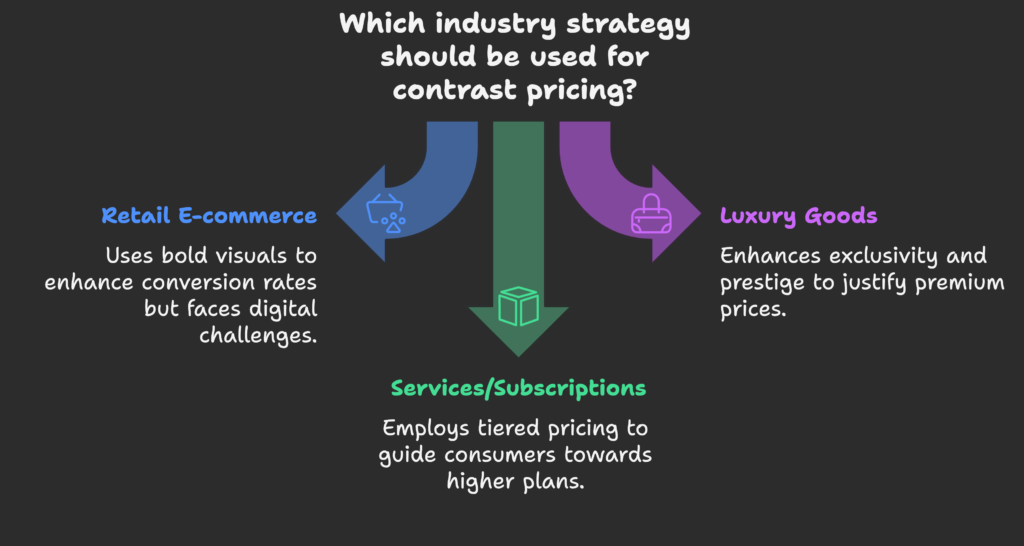Have you ever felt surprisingly drawn to a product just because it seemed like a better deal compared to something else on the shelf? Or maybe you once bought a more expensive package because the cheaper one appeared less valuable by comparison? If these scenarios sound familiar, you’ve already experienced the power of contrast in pricing. By reading this article, you’ll learn how contrast shapes what you’re willing to pay, how your brain reacts to price differences, and why companies use this strategy to boost their sales. Ready to uncover the secrets behind these pricing tricks? Let’s dive in!
Definition and Conceptual Framework
The law of contrast in pricing suggests that people view an item’s cost in relation to another reference point, rather than judging it in isolation. This means our perception of a price tag often depends on what we compare it to. Throughout history, businesses have leveraged contrast to spotlight “good deals” or justify higher price points. Today, with modern marketing tools, contrast has become more precise and powerful, shaping how consumers interpret “value” in an increasingly competitive market.
We’ll explore the concept’s deep roots, from initial psychological theories to its widespread use in modern e-commerce. But first, let’s see how our brain actually works when it interprets these contrasts. Curious? Keep going to find out.
The Neuroscience of Contrast Perception
Scientists have found that our brains use comparative judgments to figure out if something is a better or worse deal. Several studies suggest that when we see a series of different prices, the brain’s reward system (especially regions in the prefrontal cortex) becomes active. These neural activation patterns help us assess whether a price feels “acceptable” or “overpriced.”
It’s fascinating to note that contrast can light up the areas of the brain linked to motivation and decision-making, guiding us toward buying one product over another. So, we’ve seen the brain’s natural reaction to pricing comparisons. In the next section, we’ll explore the key psychological factors that make contrast so effective.
Psychological Foundations of Contrast Pricing
Now that you know how the brain processes pricing contrasts, let’s look at why people psychologically lean toward certain price comparisons. Get ready to discover how anchoring, reference points, and cultural factors influence our everyday shopping decisions.

Cognitive Biases in Price Perception
Our minds are full of cognitive shortcuts that help us make quick decisions, and one of these is the anchoring and adjustment heuristic. When we see an initial “anchor” price—say, a high original cost—our brain uses that as a starting point for evaluating subsequent offers. Because of this bias, even a moderately reduced price can seem like a great deal, as we continually reference the original figure.
We also rely on reference points that shape our sense of a product’s worth. These points could be past prices, competitor prices, or simply the next product on the shelf. This relativity of perceived value is exactly why a $50 item can seem cheap if it’s placed next to a $100 item, but it might look expensive if it’s beside a $10 item.
Think you know the basics now? Just wait until you see how these biases translate into real-life buying behavior. Let’s move on.
The Contrast Effect in Consumer Behavior
When it comes to actual purchasing decisions, contrast can act like a spotlight, highlighting or downplaying the value of certain products. If you’ve ever felt a sudden urge to buy a higher-priced option because it somehow seemed more “worth it,” you were likely experiencing the contrast effect. This phenomenon also explains why some people end up buying products they initially ignored—everything hinges on how items are compared.
It’s also worth noting that cultural and personal factors can change how strongly we feel the contrast effect. While some cultures emphasize bargain-hunting, others might see high prices as a sign of quality or status. All these layers of behavior add complexity to how people react to contrast strategies. Eager to use this knowledge in real-world pricing tactics? Let’s find out how in the next section.
Implementing Contrast in Pricing Strategies
Ready to put theory into practice? Next, we’ll discuss practical ways to bring contrast into your pricing. From simple methods like placing two products side by side to more advanced strategies that use data and personalization, there’s a lot to learn.
Basic Contrast Pricing Techniques
- High-low pricing: Showing a higher original price next to a discounted price instantly creates a sense of savings.
- Decoy pricing: Offering a “middle option” that is obviously less favorable can push people to pick the higher-priced but more valuable option.
- The power of free: Adding a “free” product or service can dramatically change how customers value paid offers in comparison.
These basic techniques show how even simple changes can make a price look like a steal. But we’re not stopping here—keep reading to learn about cutting-edge methods that blend technology and clever design.
Advanced Contrast Pricing Methods
- Dynamic pricing based on context: Prices can shift based on location, time of day, or even local events. This creates fresh contrast points for consumers, making them feel they’re getting a unique offer.
- Personalized contrast pricing: By using customer data, businesses can display different price comparisons that match individual shopping habits.
- Cross-product contrast strategies: Within a product line, placing premium and standard items side by side can steer customers toward higher-margin choices.
We’ve now learned how to actually set up these strategies. But do they really work across different industries? Let’s examine real-world examples next.
The Effectiveness of Contrast Pricing Across Industries
Ever wonder if contrast pricing works just as well for electronics as it does for luxury handbags or subscription services? This section dives into specific sectors to show you how flexible and impactful these strategies can be.

Retail and E-commerce
Online retailers often use bold visuals—like striking price slashes or limited-time offers—to create contrast. This approach can increase conversion rates and boost average order value as shoppers feel they are getting a special bargain. However, adapting contrast pricing for a purely digital environment has its own set of challenges, like cart abandonment and comparison-shopping tools. Despite these hurdles, many e-commerce brands find that well-planned contrasts can still drive significant sales growth.
Ready to move beyond retail? Let’s see how more upscale brands handle contrast next.
Luxury Goods and Premium Products
For high-end items, contrast pricing focuses on making products look even more exclusive. By displaying a much higher “comparable” cost—or positioning the product near something more common—luxury brands amplify a sense of rarity or prestige. This approach helps justify premium prices and appeals to consumers who equate higher costs with higher status.
But there’s another side to the pricing world: services and subscription models. Let’s explore how they use contrast next.
Service Industries and Subscription Models
In service and subscription businesses, tiered pricing structures often rely on contrast to guide people toward mid-level or top-tier plans. Think about the typical “Basic, Plus, and Premium” approach. The contrast between these tiers can be more influential than any single price point alone. Freemium models also use this effect, making the paid plan look substantially better than the limited free version.
Now that we’ve seen how different industries use contrast, the big question is: how do we measure success? Let’s find out.
Measuring the Impact of Contrast Pricing
You have your contrast pricing strategies in place, but how do you know if they’re actually working? In this section, we’ll talk about key metrics and research methods to evaluate both the short-term and long-term effects.
Key Performance Indicators
- Sales volume and revenue: A direct measure to see if contrast strategies are boosting total sales.
- Customer perception: Surveys or social media feedback can reveal how consumers feel about your pricing.
- Lifetime value (LTV): Monitoring whether repeated contrast offers lead to loyal customers or just one-time buyers.
Keeping track of these KPIs can provide a good snapshot of how well contrast is working. But to really drill down, researchers often go beyond standard data and use experimental methods.
Experimental Design for Contrast Pricing Research
- A/B testing: Comparing two pricing formats to see which drives better conversions.
- Eye-tracking and neuroimaging: Tools that show exactly how shoppers’ attention is captured by contrasting price points.
- Longitudinal studies: Observing customer behavior over time to check if the initial excitement around contrast fades or remains strong.
We’ve covered how to measure success, but it’s also crucial to act responsibly. Let’s look at the ethical side of contrast pricing next.
Ethical Considerations and Consumer Protection
While contrast pricing can be highly effective, it also raises questions about transparency and fairness. So how can businesses use these techniques without misleading customers?
Transparency and Fair Pricing Practices
Regulatory bodies often watch for “false discounts” or manipulated pricing. In many regions, laws require brands to show a genuine original price before labeling something as discounted. Striking the right balance between persuasion and manipulation is key to avoiding legal trouble and maintaining customer trust.
So, what does this mean for consumer well-being? Let’s explore that.
Psychological Impact on Consumer Well-being
Complex or ever-changing pricing structures can lead to stress or decision fatigue. Some shoppers may end up spending more than they intended, which can hurt their trust in the brand over time. That’s why ethical contrast pricing requires a thoughtful approach—businesses should consider long-term relationships, not just quick sales.
Now that we understand the ethical landscape, what does the future hold? Let’s see where contrast pricing is headed next.
Future Trends in Contrast Pricing
As technology evolves, so does the ability to create more refined and personalized price comparisons. In this section, we’ll look at advanced tools like AI, augmented reality, and blockchain to see how they might change the game.
Artificial Intelligence and Dynamic Contrast Pricing
AI can analyze vast amounts of data in real time to adjust prices on the fly. By tracking user behavior, AI tools can decide exactly which products to pair or compare, creating dynamic contrasts that shift as customer preferences change. Machine learning algorithms can even predict how future shoppers will respond to certain contrast scenarios, making pricing smarter and more profitable.
Ready to peek at other emerging technologies? Let’s go.
Integration with Emerging Technologies
- Augmented reality (AR) and virtual reality (VR): Imagine “trying on” different price tiers for a service in a virtual space, seeing how each feels in real time.
- Voice commerce: When shopping through voice commands, the way prices are announced can influence how large or small a difference sounds.
- Blockchain: Some companies are exploring decentralized platforms to show transparent cost breakdowns, altering how contrast is perceived.
These innovations promise to transform pricing. Now, let’s look at real examples to see these ideas in action.
Case Studies and Practical Applications
Time to wrap up theory with some actual stories of how businesses used contrast to boost sales, and also see where things went wrong. Ready to learn from success and failure? Let’s go!
Success Stories Across Different Sectors
- Technology products: Companies often highlight upgraded features and use a basic model as a decoy to make the premium version look more appealing.
- Travel industry: Bundling flight, hotel, and car rental can create a larger contrast compared to purchasing each piece separately.
- Food and beverage: Restaurants cleverly design menus, placing high-priced items at the top so other dishes seem reasonably priced by comparison.
Of course, not all strategies go as planned. Let’s examine some cautionary tales next.
Lessons from Failed Contrast Pricing Attempts
Sometimes, a high “anchor” price can backfire if it appears unrealistic or manipulative. Consumers might feel tricked and react with negative reviews or social media backlash. Brands that ignore market conditions also risk appearing out of touch, reinforcing the importance of adapting contrast pricing to stay relevant.
Now that we’ve seen both the highs and lows of contrast pricing in action, let’s bring it all together.
Conclusion and Strategic Recommendations
We’ve covered a lot of ground, from the basic psychology of comparison to advanced AI-driven tactics. So how do you turn all this insight into a winning pricing approach? Let’s see.
Best Practices for Implementing Contrast Pricing
- Keep it authentic: Always use genuine pricing history for contrasts to maintain credibility.
- Integrate with branding: Align your price contrasts with your brand image—whether that’s luxury, budget-friendly, or somewhere in between.
- Focus on long-term trust: A quick sale is great, but repeat business and positive word-of-mouth are better.
By respecting your customers and staying transparent, you can enjoy the benefits of contrast pricing without damaging your reputation. Now let’s take a final look toward the future.
The Future of Pricing in a Contrast-Aware Market
As consumers become more informed, they’ll look for authentic deals and real value. The key to standing out will be a blend of ethical practices, consistent innovation, and smart use of technology. This means adapting to new platforms, experimenting with fresh strategies, and always placing the customer’s best interests at the heart of your pricing model.
Thank you for exploring the law of contrast in pricing. Keep these insights in mind as you shape your next pricing plan, and watch how even small tweaks can make a big difference in your sales and customer happiness.
By the way, if you run a Shopify store, don’t forget the power of specialized apps like Growth Suite that can help optimize your pricing strategy and boost your conversions.
Also don’t forget to check The E-commerce Conversion Booster: Mastering Pricing & Presentation Psychology guide.
References
- Marketorium. (2024, April 2). The principle of contrast in pricing. https://marketorium.ua/en/blog/prynczyp-kontrastu-v-czinoutvorenni
- Roofing Contractor. (2011, October 11). Leadership Selling: The Law of Contrast. https://www.roofingcontractor.com/articles/86744-leadership-selling-the-law-of-contrast
- LinkedIn. (2023, June 8). How to Use the Contrast Effect in Retail Sales. https://www.linkedin.com/advice/0/how-do-you-use-contrast-effect-highlight-value-benefits
- Gupta, A. (2024, December 7). Contrast Effect. Aseem Gupta. https://aseemgupta.com/contrast-effect/
- Deloitte Deutschland. (2024, September 11). Pricing Strategy of the Future. https://www.deloitte.com/de/de/issues/innovation-ai/pricing-strategy-of-the-future.html
- Growth Tactics. (2025, February 5). What is the Contrast Effect? Everything You Need to Know. https://www.growthtactics.net/contrast-effect/
- Advanced Web Ranking. (2014, May 13). 8 Psychologically Proven Pricing Strategies that Guarantee Conversions. https://www.advancedwebranking.com/blog/eight-proven-pricing-strategies-guarantee-conversions
- Hawkes, J. (2020, July 15). The Psychology of Pricing: 1 – Contrast Pricing. LinkedIn. https://www.linkedin.com/pulse/psychology-pricing-1-contrast-james-hawkes-bsc-msc
- Janiszewski, C., & Lichtenstein, D. R. (2010). Assimilation and Contrast in Price Evaluations. Journal of Consumer Research, 36(6), 822-835.
- FasterCapital. (2024, June 18). What is Price Contrasting? https://fastercapital.com/content/What-is-Price-Contrasting.html
- Hawkes, J. (2020, September 23). The Psychology of Pricing Summary: Part One. LinkedIn. https://www.linkedin.com/pulse/psychology-pricing-summary-part-one-james-hawkes-bsc-msc
- FasterCapital. (n.d.). What Role Does Pricing Strategy Play In Creating Effective Price Contrast Campaigns? https://fastercapital.com/topics/what-role-does-pricing-strategy-play-in-creating-effective-price-contrast-campaigns.html
- Peng, L., & Liang, S. (2017). Follow Your Heart: How Is Willingness to Pay Formed under Multiple Anchors? Frontiers in Psychology, 8, 2269. https://www.frontiersin.org/journals/psychology/articles/10.3389/fpsyg.2017.02269/full





[…] Decoy Effect: Strategic Pricing to Guide Customer Choices The Law of Contrast in Pricing Strategies Using the Framing Effect to Optimize Product Descriptions Visual Persuasion: Images That Trigger […]